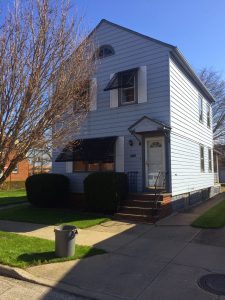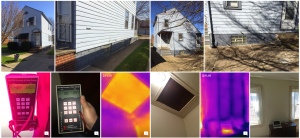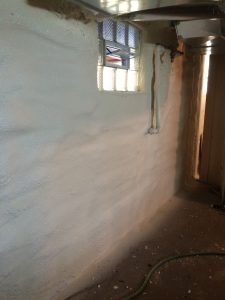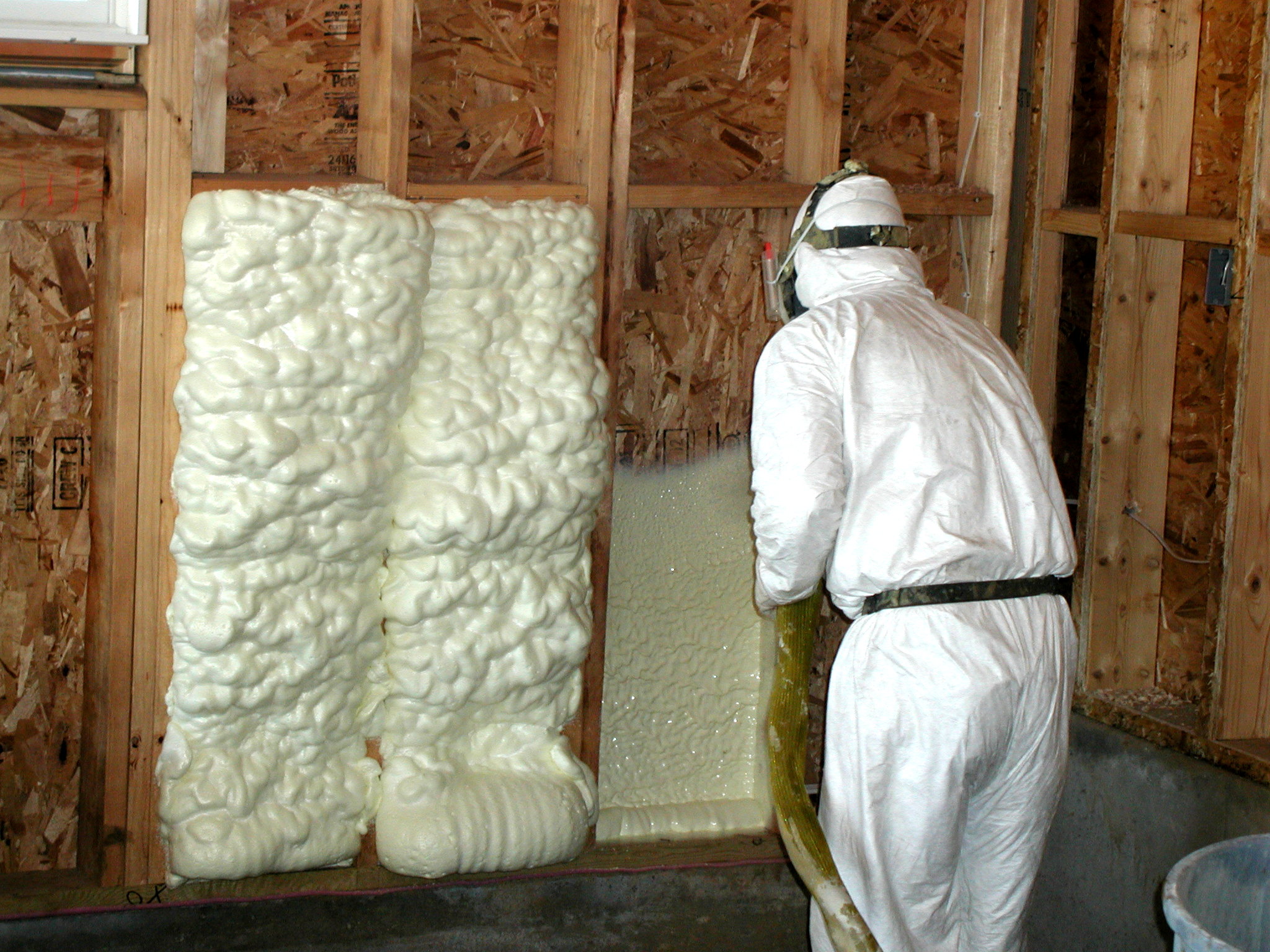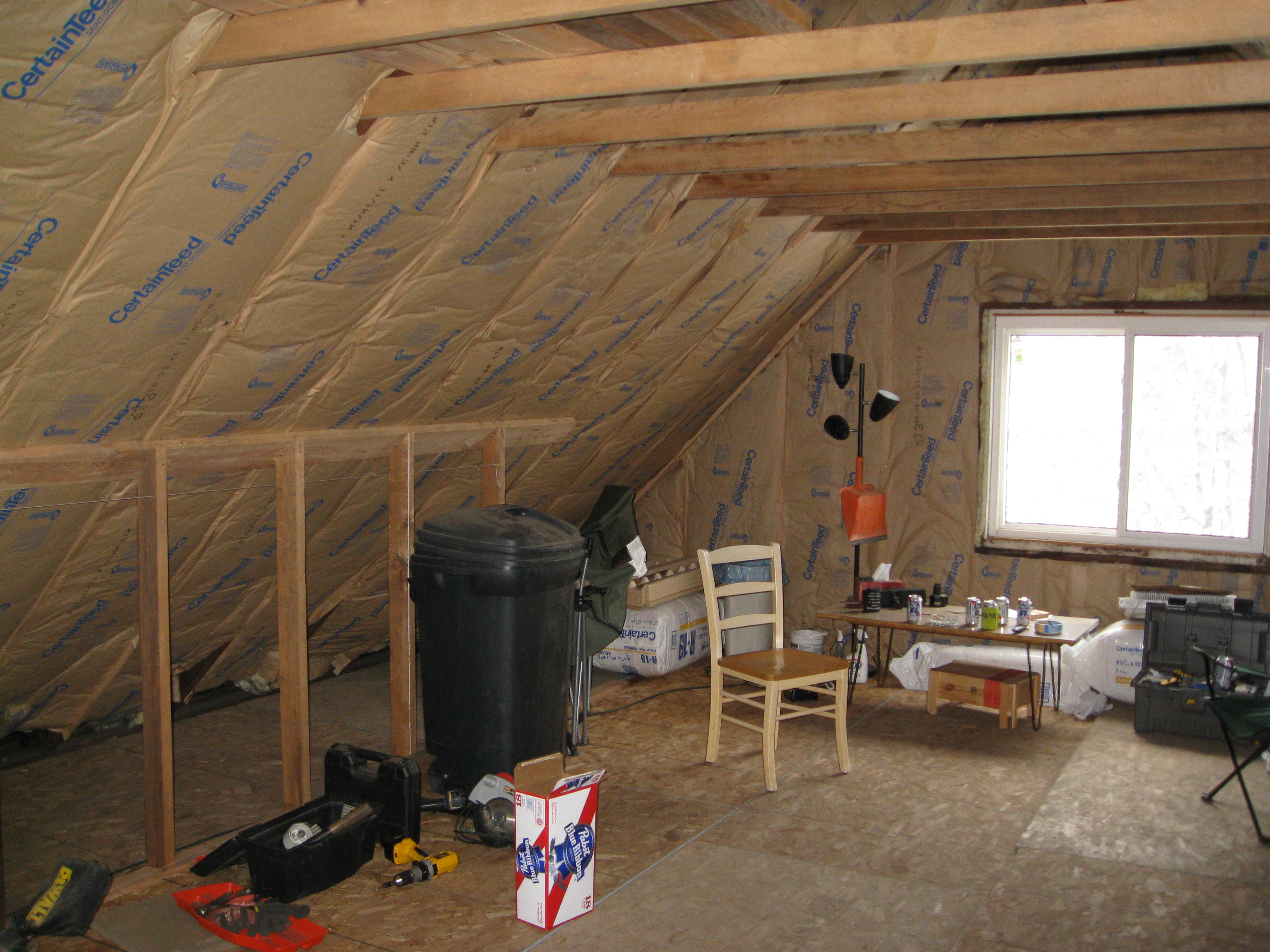Paul was committed to AC, when I got there the boiler was gone.
It's electric! This is the third home we removed the gas meter from.
Summary
Paul and Tammy are second time customers, we insulated their old house in our contracting days. Paul wanted us to tackle this one too. He’s retired and wanted a comfortable home with low operating costs. When I arrived there was a hole in the basement floor where the boiler had been: he was committed to switching to forced air. He really wanted air conditioning!
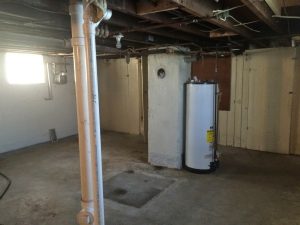
This little house is in the neighborhood he grew up in, full of delightful characters that I got to meet during the project. Paul is wonderfully cheerful and flexible to work with as well. He got a House of the Future. It’s all electric and ready for solar panels on its remarkably well suited roof. Not bad for a nearly 120 year old home!
Problems to Fix
- Recently purchased, few specific problems.
- Damp basement.
- Create remarkably comfortable home with low energy bills.
- Complete air sealing and insulation package desired.
- New forced air HVAC system for heating and cooling.
Results
- Gas meter was removed, it’s electric!
- Heat pump is so quiet, the DJ for the housewarming party set his gear up 12” from the outdoor unit.
- Second floor can be cooled to 8 degrees below the first (?!)
- Basement is dry, and usually the warmest place in the house.
Testimonial
Oh, and the house feels good to me. Hope all is well. Paul 10/28/16 Sum total of written job feedback. Paul is a man of few (written) words.
How does a 55 % improvement sound Nate. From 6100 down to 2850. The auditor, Todd praised your work quality even before the blower door test results. 9/22/11 Email after we did his first house when asked what the blower door result was.
That’s it. That’s all the written feedback I have. All the rest of our emails were about setting up the job. We’ve spent many hours on the phone together, though. Like I said, he’s a particularly pleasant client. We count each other as friends. I went to his housewarming party. And he let me walk multiple people through the house including Cameron Taylor who wrote this article about it which was republished at CleanTechnica. And he’s a second time client. And he trusted me to spend a bunch of his money in search of excellent results. I’m afraid you’ll have rely mostly on those facts as a testimonial!
Upgrades
-
Air Sealing and Insulation
- Attics – Air sealed with spray foam, R-60 cellulose installed.
- Walls – Dense packed with cellulose insulation.
- Basement – Closed cell foam sprayed on outside walls
-
HVAC
- Brand new duct installation.
- Ducts in attic were spray foamed before attic insulation was installed.
- Carrier GreenSpeed Heat Pump
- Nutone HRV 20/60 cfm
- Standard electric water heater
Photo Album
See a bunch of project photos here.
Full Story
This project was pretty much my dream: a blank slate with a good sized budget and a remarkably pleasant client. At the time I did the energy audit, I had just completed several very difficult audits and projects in very complicated homes. I pulled up to this simple box and thought “Thanks, Paul, for buying an easy one!”
Unfortunately, I had the hubris to say that, and this house vexed me the whole time, as the missed blower door target shows (my first, and hopefully last.)
Paul and I developed a rapport with his previous house when my crew (during our contracting days) reduced his air leakage by over 50%. It was such an extreme change that the gas company energy auditor checking out the job didn’t believe his gauge and tried another one. That day my crew and myself earned some cred from both the auditor and Paul.
This house came with a property tax bill 1/10 the old one and a much lower purchase price. Paul wanted to dig in, be comfortable, and have low operating costs. Paul told me to “do it right.”
Whenever possible, I like to remove gas meters and make homes all electric. It’s looking like electricity is going to be the cheapest fuel source, and we can get it from the wind and sun. In fact, this house has amazing solar exposure, which is especially rare because it’s in the middle of the city. Heat pumps (air conditioners that can cool and heat) provide amazing comfort when used properly.
Floating the all electric option is always a bit sticky. Paul is kind of old school, so I planted the seed and let it grow for a few weeks. In this case the seed grew into a nice plant and we got rid of the gas meter (my third at the time.) He used to work for the electric company, and his buddies told him he was nuts. They told him, “Heat pumps don’t work in Cleveland!” Thankfully, he trusted me, and we did a heat pump.
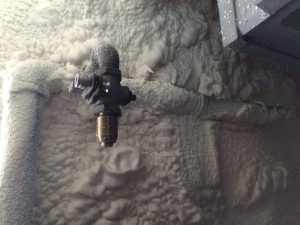
Since he wanted forced air so he could have air conditioning for the first time (and a heat pump is forced air), we needed to add ductwork. We no longer needed the chimney, so Paul rounded up a crew to make it disappear and to fill in the hole in the roof. (Being a blue collar guy he was constantly telling me he had a guy for that…) We also did a duct design, which specifies what size duct needs to be run to each room.
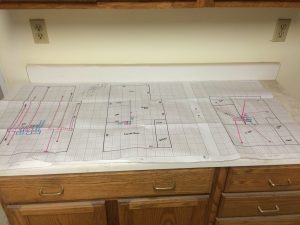
Even with the chimney gone, we were a little light on space for ductwork. Dave, the installer for Wright Heating and Cooling in Kent who put it in, disregarded the duct design and downsized the supply trunk to the upstairs (air blowing up). I was nervous about it, but since he disregarded the duct design, if it didn’t work it would be his problem to fix.
Since the ductwork was running through the attic, a big no-no in most cases, we wanted to spray foam the snot out of it to reduce leakage. Ductwork in attics is typically leaky, which is a double whammy. Not only are you pushing heated or cooled air into the attic, but that air is coming out of the house, so more air has to come into the house somewhere else. I HATE ducts in attics, and here I was having them put in!
I gave Dave the option to be there when my friend Walter Money of Whole House Energy Solutions and I tested the HVAC system for leakage before and after the foam, he didn’t show interest. Not surprisingly, the system was pretty leaky before the foam. I also checked the temperature of the air conditioned air coming out of the vents, and it was extremely high, only a few degrees below the room temperature. Translation: the air conditioning didn’t work with leaky, uninsulated ducts.
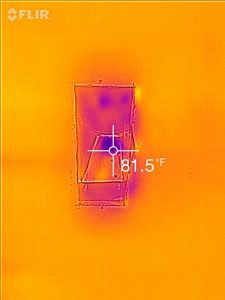
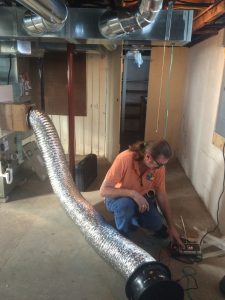
Once the ducts had been spray foamed while Affordable Foam air sealed the attics, I spent some time applying “mastic” to the leaky basement joints of the ductwork. Mastic is also used to glue tile down and can handle the expansion and contraction of the ductwork as it heats up and cools down.
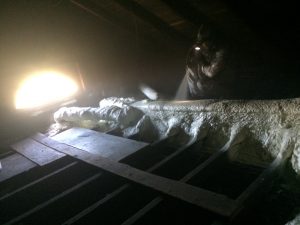
All that work paid off, the ducts leak very little to the outdoors despite going through the attic, good enough, in fact, to pass the latest (2015) energy code. (51 cfm25 leakage to outdoors for my energy geek readers.) They were still leakier than I’d hoped, but far better than most installs.
We also spray foamed the basement walls. The basement was particularly damp, largely because water from the gutters pooled against the house – it wasn’t sloped away enough. Some of that has been addressed, but I wanted to reduce moisture intrusion as much as possible. Originally the basement wall foam wasn’t in the plan, but Paul decided to pull the trigger on it.
The basement is now pretty dry (thanks also to a dehumidifier), and Paul set up his office down there. I call the house “The Upside-Down House” because in the summer the second floor is coldest, then the first floor, with the basement being the warmest. The second floor can be cooled to be 8-10 degrees cooler than the other floors! It does take much more adjustment than it should, but thankfully Dave changing the size of the second floor supply duct trunk didn’t cripple us. Here is a chart of the temperatures on the different floors:
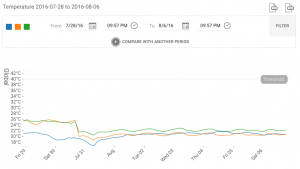
The walls of the house were uninsulated, so I brought in Fred Skillicorn of Insulation Systems to tackle the walls. Good wall insulation is 100% in the hands of the installer. It’s all technique. Dense packing wall insulation is like putting 3 pounds of stuff in a 2 pound box. It takes patience and thought.
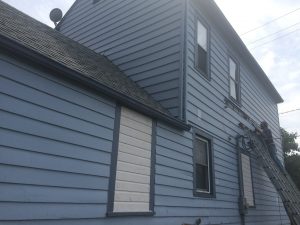
The house turned out to have two wall cavities in many places, which led to less than satisfying air leakage reductions. Paul thankfully was game for a sweetener and we offered the crew members $50 each if they could hit an 1800 cfm50 target, a 54% reduction from the start. It worked, they buckled down and found weird spots to fill, we foamed some unusual leaks we found, and they caulked anything that looked like it might leak. We missed the 1800 target by a hair, 1820 was our final, but Fred’s crew helped us get much further than we would have otherwise. They got the bonus.
In case you’re wondering, I know where a big chunk of that extra leakage is. The house actually has two ceilings on both the first and second floor. I suspect the plaster broke somewhere and rather than repair it, they built a ceiling 8” below the original one. The cavity for that is not easy to get to, and Paul and I decided to see how it went first, then spend the money if he thought it was worth it.
Now that the ductwork was installed and all of the air sealing and insulation was complete, it was time to set up the heat pump.
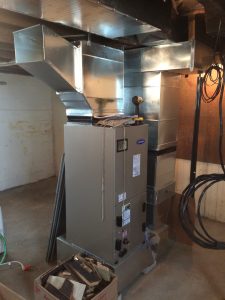

We used my personal favorite, a Carrier GreenSpeed heat pump. It is a “modulating” unit, which means it has a throttle. Most furnaces/air conditioners/heat pumps are only single stage – they are either on or they are off. This product will vary from about 50% up to 100% in 1% increments, not unlike the gas pedal in your car. This is important because equipment is very efficient at lower speeds and also is much quieter. Low speed on this unit was quiet enough we had to ask everyone to stop talking and stand only a foot or two away. I clocked it at just over 40 decibels, most conversations are over 50!
I’ve spent a lot of time learning the ridiculously complex thermostat for this unit, I joke that it does everything but your laundry. I spent an hour or so going through deep settings to make it run as efficiently as possible. At another client home, we noted that these heating settings dropped energy use by 30-60%! All with the push of a button, but you have to know which one. The company that installed my other client’s GreenSpeed didn’t know the setting…
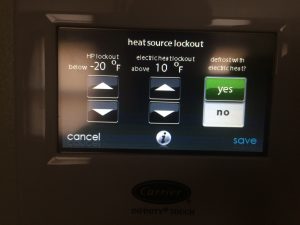
Due to some unfortunate family circumstances, Paul didn’t end up moving in until after the winter, so I got to see the energy use of the home unoccupied (and set to only 52 for heating.) Not surprisingly, it became by far the most efficient home that I’m tracking. I’m curious to see what happens this winter!
Now that Paul and his wife have moved in now, I actually noticed because I’ve been tracking their energy bills and noticed a big bump! (Paul’s wife Tammy is amazing, she not only gave up wall to wall carpeting for Indoor Air Quality purposes, but also trusted me and bought an induction stove, and loves it!)
Once they were in, I started watching their thermostat from afar and noted worryingly high humidity levels. High humidity can cause all sorts of problems. Poor comfort is a big one, but this house also had issues with mold in the basement, and I did not want to give it a chance to grow. If you starve mold of moisture, it pretty much stays put. (It’s more complicated than that, but too much to go into now.)
A bit freaked out by the moisture, I brought three Foobot Indoor Air Quality monitors up and placed one on each floor. The basement stayed very dry because of the dehumidifier, but the first and second floors were too wet (frequently above 60% relative humidity, the danger level.)
Paul and Tammy had a housewarming party, so naturally I showed up with a sawzall and test equipment. Knowing Paul’s excellent demeanor, I played a trick on him and used the sawzall to open up a hole in the return duct in the basement. It worked, it scared the heck out of him and got a laugh out of me. Now some of the dry air from the basement could be pulled into the rest of the house. It worked reasonably well, not perfect, but good enough. Here is the chart:
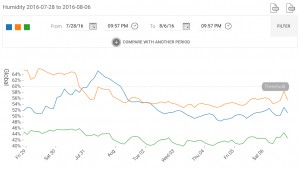
A great thing happened at that party – I noticed that the DJ set up his equipment less than a foot from the outdoor unit of the heat pump. It shows you how quiet the thing is. You can literally lean on it and talk with no strain at all. Higher end units tend to be quiet like that.

Through it all, Paul put an almost scary amount of trust in me, and also let me do pretty much anything I wanted to his house. I had a blast! The humidity issue is still driving me a bit nuts, and I’m still pretty annoyed I missed my air leakage target of 1500 by over 300 points, but Paul and Tammy are really happy, and one more home is all electric. It’s possible to buy 100% renewably produced electricity for the same price as normal electricity here in Cleveland, so this house doesn’t need to use any more fossil fuels!
This little house truly is a House of the Future. I’m very thankful that Paul and his wife gave me nearly free reign to make their new home something truly special!
What to Do Next
Want to learn more about what this might mean for your home? It all starts with learning. Be sure to download the free Home Performance 101 guide to your right, it will teach you how your home really works. Then you can begin the path of making a plan and executing it. But start with HP101!
Detailed Numbers
Electric Use Before Not Occupied
Predicted Use After 14,981 kWh
Actual Use After 11,141 kWh (unoccupied with mild winter)
Duct Leakage
- Before 307 cfm25
- Predicted 100 cfm25
- After 162 cfm25
Load Calculation
- Before 36,895 BTU/hr heating
- Predicted 20,008 BTU/hr heating
- After N/A
- Before 16,736 BTU/hr cooling
- Predicted 11,826 BTU/hr cooling
- After N/A


